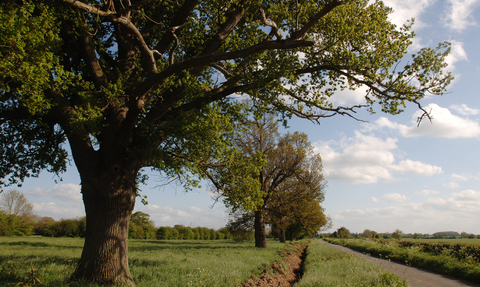
Claylands row of trees (credit: M. Watson)
Trees
Trees are a fantastic feature of the Norfolk landscape and a vital support system for a range of wildlife. Our oldest trees also hold immense historical value, with some being more than 1,000 years old.
Ancient trees
Ancient trees have survived centuries of changes and historical events, but they are also key habitats for many different wildlife species. Once lost, ancient trees can never be replaced.
The older a tree becomes, the more important it is for wildlife. As a tree ages, it provides increasing habitats and ‘niches’ which are used by a growing range of wildlife. These will include holes and hollows within the tree, areas of decay, flaking bark, pools of water, and an increasingly complex underground web of roots and associated fungi.
An ancient tree can stand alone or be part of a woodland. These trees can be identified by their large, gnarled, knotted, and hollow appearance with often small canopies and wide coarse trunks as they attain natural maturity and reach the final stage of their lifecycle. At this point, they are still likely to survive for many more years, and even as they deteriorate, and eventually die, they will continue to hold huge value.
Ancient trees contain their own ecosystem and need little management unless they pose a danger to life. They will contain fungi from root to leaf and release nutrients which are important to the plants and trees around them. They are also a food source for insects, such as beetles, and mammals, such as mice and squirrels. Many invertebrates rely on decaying wood (up to 2,000 species in the UK). Ancient trees are very important for these creatures because there is a shortage of deadwood in the UK. Finally, lots of lichens take many, many years to grow and ancient trees between the ages of 150 and 5,000 years old make a perfect place for them to grow. The loss of these trees will mean the loss of many associated species.
It is important to protect our existing ancient trees in the landscape, as well as planting more trees to become the ancient trees of the future.
Hedgerow trees
Hedgerow trees are an important resource for wildlife. Over half of the priority species associated with hedgerows rely on hedgerow trees. Birds nest in trees and use them as territory markers or song-posts. Hedgerow trees are also extremely important for bats.
Pollarding trees
Pollarded trees have had their top and upper branches removed, creating a distinct growth of branches from a noticeably thickened trunk. Pollarding means that valuable timber can be extracted from the tree, and it can also prolong the life of the tree by prompting renewed growth.
Useful links
| Tree species | The National Trust's guide to identifying British trees | National Trust - tree ID guide |
| Ancient trees |
The Ancient Tree Forum have a thorough guide to ancient and veteran trees. See the Woodland Trusts map the oldest and most important trees in the UK. Natural Engaland have an interactive map of ancient woodlands.
|
Ancient Tree Forum - ancient and veteran trees |
| Hedgerow trees |
PTES have a guide to the value and benefits of hedgerow trees. This report from Natural England answers 18 common questions about hedgerow trees. |
|
| Pollarding trees | NWT factsheet on pollards and wildlife | |
| Tree planting | Warwickshire Wildlife Trust have created a flow chart and infographic to guide you through if and where it is best to plant trees. | Warwickshire Wildlife Trust - Considering if a site is suitable for tree planting |
